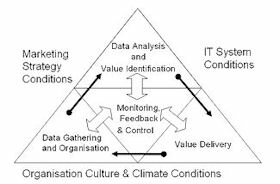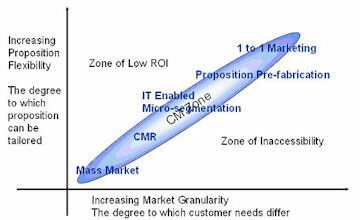Models
Through study of exemplar organisations and focused research projects, the centre has developed a number of models and tools to assist organisations who are intent on improving their service to customers. They include:-
- Assessing the status of pre-conditions for successful implementation of Customer Management (CM) - The CM Space
- A model for functional CM - Four Sub-processes within the CM space
- Assessing your position in the CM Eco-System
- Assessing organisational climate
The CM SpaceWhat emerged from early research was the conclusion that implementing CM (Customer Management) is only effective in a ‘space’ bounded by three sets of conditions (see diagram on the right). The difficulties of meeting all three sets of conditions is what makes effective CM so difficult to implement but also so difficult for competitors to copy. If you wish, you can download an excel spreadsheet model to make an initial estimate of your own CM Space. Please click on the link below.
|

The conditions are best summarised as follows: Marketing strategy conditions CM does not make up for weak strategy. If the marketing strategy does not define real segments and distinct value propositions, or if that strategy does not leverage real strengths and minimise relative weaknesses, then it is the marketing planning process that needs investment, not the CM system. CM will only work in situations where the target markets place some real value on closely tailored propositions. IT conditions It is essential that the provision of IT systems should follow strategy. The IT system should be designed around the requirements of the marketing strategy, then managed to that goal, not the technical specification. Further, the IT project must be given adequate tangible resources and, critically, the support of the top management team. Organisational culture and climate The importance of organisational culture in delivering excellent customer service cannot be over-emphasised. In effective CM organisations, culture and climate are as important to CM as they are to any other management process. More specifically, the values of organisational culture must be aligned to the market, be commonly held and yet still remain flexible. Without those three attributes, organisational culture hinders rather than helps CM. Equally, the best CM system will fail if the employee attitudes and perceptions of organisational climate are negative. |
A Model for Functional CMTruly successful organisations take a holistic view of a relationship and a complete CM system contains four distinct sub processes that feed into each other in a loop. By continual re-iteration of this process, successful CM companies gradually hone their targeting and propositions, creating competitive superiority over less focused rivals. |

The sub-processes are: Data gathering Customer data is selectively gathered and organised by segment or group. Data that says something about customer motivations, like purchasing patterns and complaints, is especially important. This segment-based motivation data is then fed into the next process. Data analysis and value identification The segment data is analysed by a combination of statistical and intuitive methods to reveal insights into customer motivations and behaviour. At this point both quantitative analysis and qualitative analysis must be used together. The output is in two parts. First, this sub-process can identify new groups or segments that more accurately describe customer behaviour and market conditions. Secondly, it suggests value propositions to satisfy those segments. Value delivery At this point, analysis turns to action. Changes are made to the processes and systems used by the organisation to manage customer relationships based on the newly defined segments and propositions. In particular, the number and type of touch points experienced by a customer may change. From this point, data gathering in stage one must now be based on the new segments, so starting the iterative loop. Monitoring, feedback and control At the centre of the loop lies the critical control sub process. This takes as its inputs the costs and outputs of each of the three other stages. Hence it ensures that the segment and proposition changes indicated by the CM process are financially viable in the short term and make overall strategic sense. These four key components are fundamental to CM effectiveness. Excellence in some of them cannot compensate for weakness in any one of them. The type of data used, the analyses made and the value created are organisation specific. However, the core of the process is generic and independent of business context. |
The CM Eco-SystemAnother important finding from our research was the differences between companies, both in their market environments and in what they offered the market. Two key dimensions emerged: If you wish, you can download an excel spreadsheet model to make an initial estimate of your own position in the CM Eco System. Please click on the link below.
|

Market granularity. Some markets were very homogeneous,with only one or two segments. Others were very complex,with dozens of segments and very individual customers. Market granularity is a function of the market, not the company. Proposition flexibility. Some companies had propositions that could be infinitely tailored to the customer whilst others were much more standardised. Proposition flexibility is a function of both industry and company. Whilst these two ideas seem at first to be academic and esoteric, they proved to be essential to making CM work. CM was only worthwhile when the two factors were relatively evenly balanced; that is, when the granularity of the market and the flexibility of the proposition were about the same. When the market contained few segments but the company could tailor much more finely, CM could be achieved but it was unprofitable. We called this the “zone of low return on investment (ROI)”.The converse was when the market was very granular and crying out for tailored propositions, but the company was unable to deliver them. This we called the “zone of inaccessibility”. In between these two zones lay the narrow strip of conditions where CM was worthwhile. This finding was very important as it told companies when to invest in CM and when to adopt a different strategy. Because it involved companies adapting to market conditions, we called this idea the “CM ecosystem”. Through looking at successful companies, we observed that the basic CM process was, in practice, adapted in detail so that each successful CM project was different. Clearly, no one approach to CM was the best way, but we needed to understand what it was that made each approach best for a particular situation. The answer came as we looked in more detail at the successful companies and their CM ecosystems. In short, a different subspecies of CM was appropriate to each different level of market granularity and proposition flexibility. Although every successful CM process is different at a microscopic level, we found they could be usefully classified into one of five sub-species. Each one followed the basic model, but varied in terms of data used, analysis employed, value created and controls applied. The five sub-species are:- Mass market Used in markets with little proposition flexibility or market granularity. Little or no customer differentiation or customisation; data used to optimise supply chain management processes rather than CM Customer-managed relationship (CMR) Used in relatively homogeneous niches where proposition flexibility is technically limited. Customisation via “opt-in” proposition components to allow self-tailoring by customers from a “proposition buffet”; data used to provide design components IT-enabled micro-segmentation Used in markets with clear segmentation and moderately flexible propositions. Modification of the most flexible components of basic segment proposition, such as price and promotion; data used to modify basic segment propositions Proposition prefabrication Used in fragmented markets where proposition flexibility is high but expensive. Proposition customised by assembly from economically made components and “wrapped” in personalised packaging One-to-one Used in very heterogeneous markets where proposition flexibility is high and inexpensive. Proposition individually tailored; data used to design proposition and ensure quality and synergy across targets. |
Assessing Organisational Climate |
Please see seperate page using the link: climate survey |
 return to top
return to top